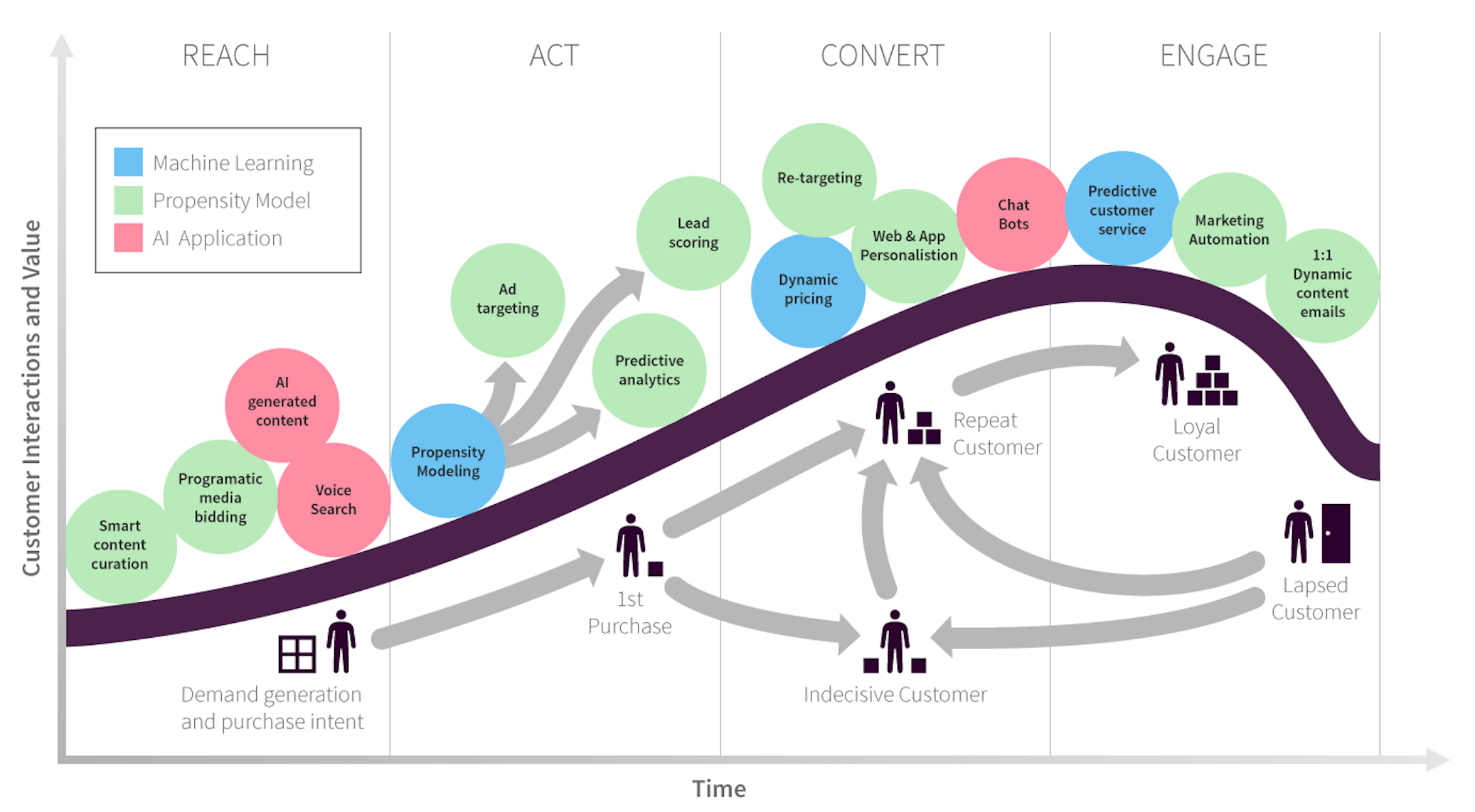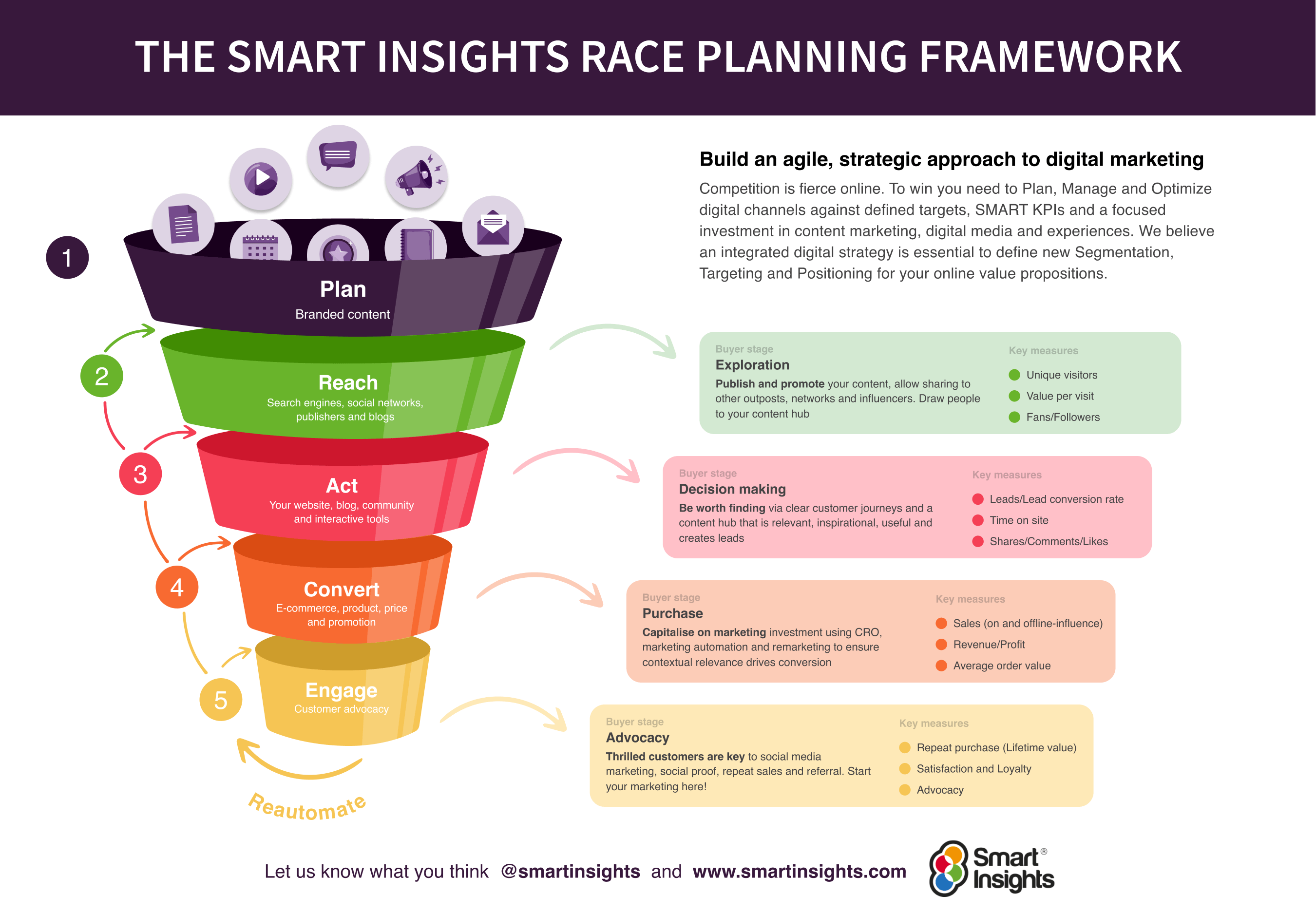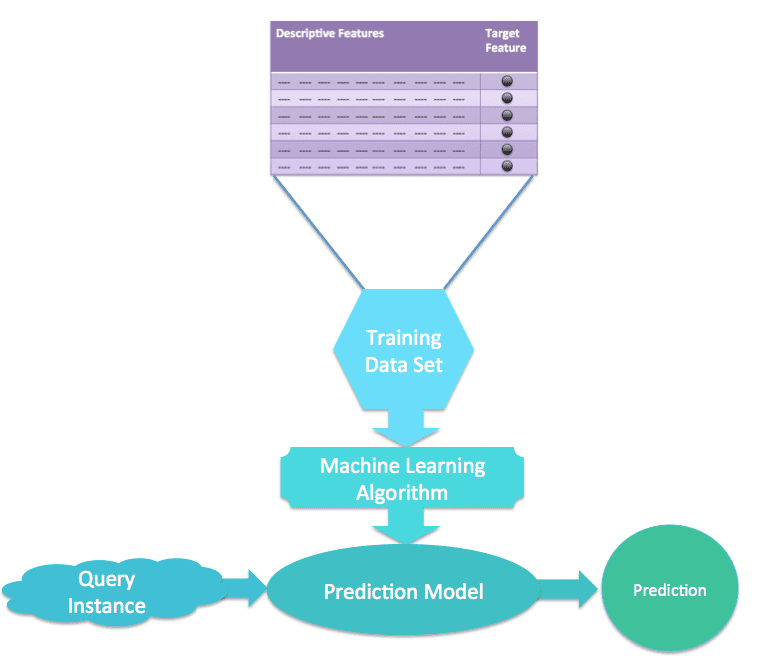Mapping the most effective AI technologies for marketing across the customer lifecycle in the coming year
Artificial Intelligence (AI) technology is a hot topic in marketing at the moment, with the huge interest in ChatGPT (see our articles on using ChatGPT for marketing).
But AI is a broad term covering a wide range of different technologies, many of which have been available for some time. We originally wrote this article based on the opportunities for using AI for marketing in 2017 and have updated it since with examples.
Artificial intelligence means any technology that seeks to mimic human intelligence, which covers a huge range of capabilities such as voice and image recognition, machine learning techniques and semantic search.
That's why, in our AI and Machine Learning briefing for members, we have identified fifteen artificial intelligence techniques that businesses of all sizes can implement, rather than techniques that only major tech giants can devote resources to. We've plotted the techniques across the customer lifecycle so you can see how each AI tactic can help take your customers down the marketing funnel.

Core Module

Introducing AI for marketing
Part of the Sector technology innovation Toolkit
Learn how you can use AI for marketing, looking at the top-level capabilities of AI in a business and how to distinguish between tools.
Learn More
All the techniques are 'AI' in the sense that they involve computer intelligence, but we've broken them down into 3 different types of technology - Machine learning techniques, applied propensity models, and AI applications. Machine learning techniques involve using algorithms to 'learn' from historical data sets, which can then create propensity models. Applied propensity models are when these propensity models are put to work predicting given events- such as scoring leads based on their likelihood to convert. AI applications are other forms of AI, which do tasks one would usually associate with a human operator such as answering customer questions or writing new content.
Each different application has major implications for marketers, but the applications have different roles to play across the customer journey. Some are better for attracting customers, whilst others are useful for conversion or re-engaging past customers. That's why we've divided the techniques across the RACE framework.

If you're looking to apply technology to optimize your marketing strategy, our RACE Framework is the perfect structure for you to plan and assess your marketing activities. Through the journey of reach, act, convert, and engage, our RACE Framework empowers marketers and managers to apply customer insights and data to measure and prioritize their best-performing omnichannel touchpoints.
Core Module

Introducing AI for marketing
Part of the Sector technology innovation Toolkit
Learn how you can use AI for marketing, looking at the top-level capabilities of AI in a business and how to distinguish between tools.
Learn More
Reach - Attract visitors with a range of inbound techniques
Reach involves using techniques such as content marketing, SEO and other 'earned media' to bring visitors to your site and start them on the buyer's journey. AI and applied propensity models can be used at this stage to attract more visitors and provide those that do reach your site with a more engaging experience.
1. AI-generated content
This is a really interesting area for AI. AI can't write a political opinion column or a blog post on industry-specific best practice advice, but there are certain areas where AI-generated content can be useful and help draw visitors to your site.
For certain functions AI content writing programs are able to pick elements from a dataset and structure a ‘human-sounding’ article. An AI writing program called ‘WordSmith’ produced 1.5 billion pieces of content as early as 2016.
AI writers are useful for reporting on regular, data-focused events. Examples include quarterly earnings reports, sports matches, and market data. If you operate in a relevant niche such as financial services, then AI-generated content could form a useful component of your content marketing strategy. There are now solutions from vendors available and returning good results in copywriting for Facebook Ads, email subject lines and nurturing emails that we highlight in the latest edition of our AI guide.
2. Smart content curation
AI-powered content curation allows you to better engage visitors to your site by showing them content relevant to them. This technique is most commonly found in the 'customers who bought X also bought Y' section on many sites, but can also be applied to blog content and personalizing site messaging more widely. It's also a great technique for subscription businesses, where the more someone uses the service, the more data the machine learning algorithm has to use and the better the recommendations of content become. Think of Netflix's recommendation system being able to consistently recommend to you shows you'd be interested in.
3. Voice search
Voice search is another AI technology but, when it comes to using it for marketing, it's about utilizing the technology developed by the major players (Google, Amazon, Apple) rather than developing your own capability. Voice search will change future SEO strategies, and brands need to keep up. A brand that nails voice search will leverage gains in organic traffic with high purchase intent thanks to increased voice search traffic due to AI-driven virtual personal assistants.
4. Programmatic media buying
Programmatic media buying can use propensity models generated by machine learning algorithms to more effectively target ads at the most relevant customers. Programmatic ads need to get smarter in the wake of Google's brand safety scandal. It was revealed ads placed programmatically through Google's ad network were appearing on terrorist's websites. AI can help here by recognizing questionable sites and removing them from the list of sites ads can be placed on.
Act - Draw visitors in and make them aware of your product
5. Propensity modelling
As already mentioned, propensity modelling is the goal of a machine learning project. The machine learning algorithm is fed large amounts of historical data, and it uses this data to create a propensity model which (in theory) is able to make accurate predictions about the real world. The simple diagram below shows the stages of this process.

6. Predictive analytics
Propensity modelling can be applied to a number of different areas, such as predicting the likely hood of a given customer to convert, predicting what price a customer is likely to convert at, or what customers are most likely to make repeat purchases. This application is called predictive analytics because it uses analytics data to make predictions about how customers behave. The key thing to remember is that a propensity model is only as good as the data provided to create it, so if there are errors in your data or a high level of randomness, it will be unable to make accurate predictions.
7. Lead scoring
Propensity models generated by machine learning can be trained to score leads based on certain criteria so that your sales team can establish how 'hot' a given lead is, and if they are worth devoting time to. This can be particularly important in B2B businesses with consultative sales processes, where each sale takes a considerable amount of time on the part of the sales team. By contacting the most relevant leads, the sales team can save time and concentrate their energy where it is most effective. The insights into a lead's propensity to buy can also be used to target sales and discounts where they are most effective.

8. Ad targeting
Machine learning algorithms can run through vast amounts of historical data to establish which ads perform best on which people and at what stage in the buying process. Using this data they can serve them with the most effective content at the right time. By using machine learning to constantly optimize thousands of variables you can achieve more effective ad placement and content than traditional methods. However, you'll still need humans to do the creative parts!
Convert - nudge interested consumers into becoming customers
9. Dynamic pricing
All marketers know that sales are effective at shifting more product. Discounts are extremely powerful, but they can also hurt your bottom line. If you make twice as many sales with a two-thirds smaller margin, you've made less profit than you would have if you didn't have a sale.
Sales are so effective because they get people to buy your product that previously wouldn't have considered themselves able to justify the cost of the purchase. But they also mean people that would have paid the higher price pay less than they would have.
Dynamic pricing can avoid this problem, by targeting only special offers only at those likely to need them in order to convert. Machine learning can build a propensity model of which traits show a customer is likely to need an offer to convert, and which are likely to convert without the need for an offer. This means you can increase sales whilst not reducing your profit margins by much, thus maximizing profits.
10. Web and app personalisation
Using a propensity model to predict a customer's stage in the buyer's journey can let you serve that customer, either on an app or on a web page, with the most relevant content. If someone is still new to a site, content that informs them and keeps them interested will be most effective, whilst if they have visited many times and are clearly interested in the product then more in-depth content about a product's benefits will perform better.
11. Chatbots
Chatbots mimic human intelligence by being able to interpret consumer’s queries and complete orders for them. You might think chatbots are extremely difficult to develop and only huge brands with massive budgets will be able to use them. Actually, using open chatbot development platforms, it's relatively easy to create your own chatbot without a big team of developers.
Our AI guide highlights open source technologies from Facebook and Google which brands such as Dominos and KLM are using for developing their own chatbots for customer service.
12. Re-targeting
Much like with ad targeting, machine learning can be used to establish what content is most likely to bring customers back to the site based on historical data. By building an accurate prediction model of what content works best at winning back different types of customers, machine learning can be used to optimize your retargeting ads to make them as effective as possible.
Engage - keep your customers returning
13. Predictive customer service
It's far easier to make repeat sales to your existing customer base than it is to attract new customers. So, keeping your existing customers happy is key to your bottom line. This is particularly true in subscription-based business, where a high churn rate can be extremely costly. Predictive analytics can be used to work out which customers are most likely to unsubscribe from a service by assessing what features are most common in customers who do unsubscribe. It's then possible to reach out to these customers with offers, prompts or assistance to prevent them from churning.
14. Marketing automation
Marketing automation techniques generally involve a series of rules, which when triggered initiative interactions with the customer. But who decided these rules? Generally, a marketer who's basically guessing what will be most effective. Machine learning can run through billions of points of customer data and establish when are the most effective times to make contact, what words in subject lines are most effective and much more. These insights can then be applied to boost the effectiveness of your marketing automation efforts.
15. 1:1 dynamic emails
In a similar fashion to marketing automation, applying insights generated from machine learning can create extremely effective 1:1 dynamic emails. Predictive analytics using a propensity model can establish a subscriber's propensity to buy certain categories, sizes and colours through their previous behaviour and displays the most relevant products in newsletters. The product stock, deals, pricing is all correct at the time of opening the email.
There are so many new AI and machine learning services developing, it can be difficult to know where to begin. Our AI for Marketing Learning Path you cut through the hype and noise around these powerful technologies to make the right decisions for your business.
It provides models and strategies to successfully run these projects and gives examples and case studies of how the technology is used in businesses of all sizes and industries, with an actionable and practical approach.
Core Module

Introducing AI for marketing
Part of the Sector technology innovation Toolkit
Learn how you can use AI for marketing, looking at the top-level capabilities of AI in a business and how to distinguish between tools.
Learn More












